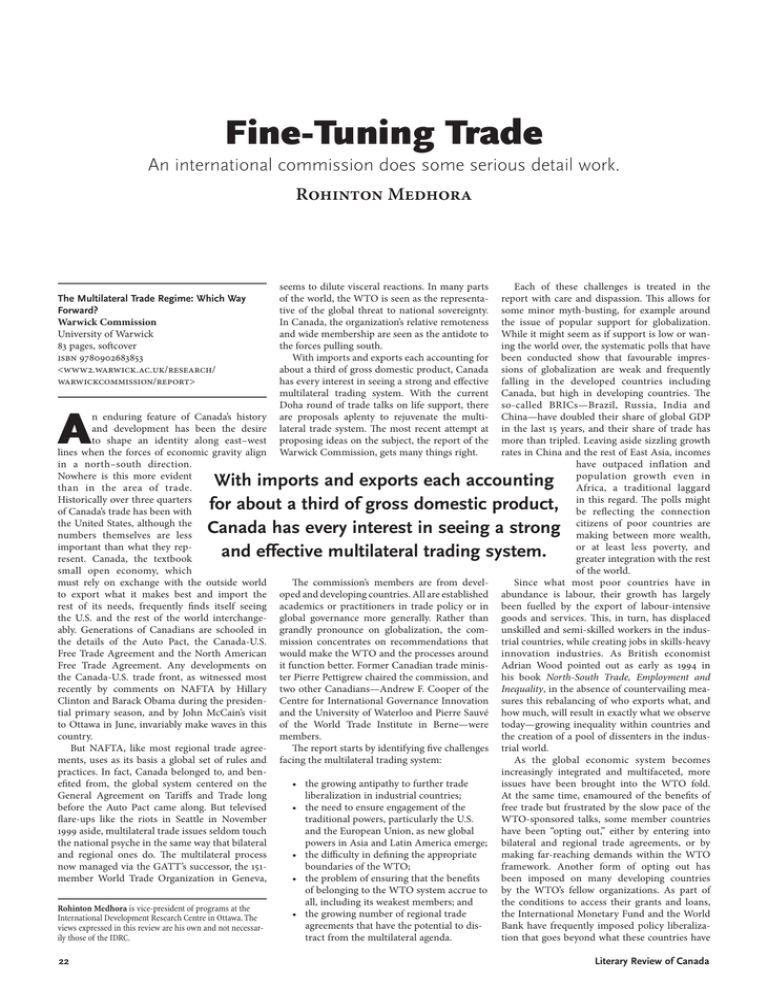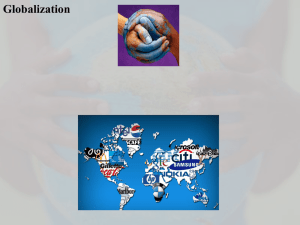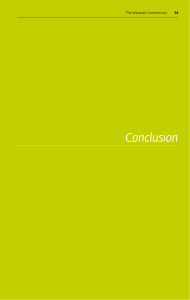The Multilateral Trade Regime: Which Way
advertisement

Fine-Tuning Trade An international commission does some serious detail work. Rohinton Medhora The Multilateral Trade Regime: Which Way Forward? Warwick Commission University of Warwick 83 pages, softcover ISBN 9780902683853 <www2.warwick.ac.uk/research/ warwickcommission/report> A n enduring feature of Canada’s history and development has been the desire to shape an identity along east–west lines when the forces of economic gravity align in a north–south direction. Nowhere is this more evident than in the area of trade. Historically over three quarters of Canada’s trade has been with the United States, although the numbers themselves are less important than what they represent. Canada, the textbook small open economy, which must rely on exchange with the outside world to export what it makes best and import the rest of its needs, frequently finds itself seeing the U.S. and the rest of the world interchangeably. Generations of Canadians are schooled in the details of the Auto Pact, the Canada-U.S. Free Trade Agreement and the North American Free Trade Agreement. Any developments on the Canada-U.S. trade front, as witnessed most recently by comments on NAFTA by Hillary Clinton and Barack Obama during the presidential primary season, and by John McCain’s visit to Ottawa in June, invariably make waves in this country. But NAFTA, like most regional trade agreements, uses as its basis a global set of rules and practices. In fact, Canada belonged to, and benefited from, the global system centered on the General Agreement on Tariffs and Trade long before the Auto Pact came along. But televised flare-ups like the riots in Seattle in November 1999 aside, multilateral trade issues seldom touch the national psyche in the same way that bilateral and regional ones do. The multilateral process now managed via the GATT’s successor, the 151member World Trade Organization in Geneva, seems to dilute visceral reactions. In many parts of the world, the WTO is seen as the representative of the global threat to national sovereignty. In Canada, the organization’s relative remoteness and wide membership are seen as the antidote to the forces pulling south. With imports and exports each accounting for about a third of gross domestic product, Canada has every interest in seeing a strong and effective multilateral trading system. With the current Doha round of trade talks on life support, there are proposals aplenty to rejuvenate the multilateral trade system. The most recent attempt at proposing ideas on the subject, the report of the Warwick Commission, gets many things right. Each of these challenges is treated in the report with care and dispassion. This allows for some minor myth-busting, for example around the issue of popular support for globalization. While it might seem as if support is low or waning the world over, the systematic polls that have been conducted show that favourable impressions of globalization are weak and frequently falling in the developed countries including Canada, but high in developing countries. The so-called BRICs—Brazil, Russia, India and China—have doubled their share of global GDP in the last 15 years, and their share of trade has more than tripled. Leaving aside sizzling growth rates in China and the rest of East Asia, incomes have outpaced inflation and population growth even in Africa, a traditional laggard in this regard. The polls might be reflecting the connection citizens of poor countries are making between more wealth, or at least less poverty, and greater integration with the rest of the world. Since what most poor countries have in abundance is labour, their growth has largely been fuelled by the export of labour-intensive goods and services. This, in turn, has displaced unskilled and semi-skilled workers in the industrial countries, while creating jobs in skills-heavy innovation industries. As British economist Adrian Wood pointed out as early as 1994 in his book North-South Trade, Employment and Inequality, in the absence of countervailing measures this rebalancing of who exports what, and how much, will result in exactly what we observe today—growing inequality within countries and the creation of a pool of dissenters in the industrial world. As the global economic system becomes increasingly integrated and multifaceted, more issues have been brought into the WTO fold. At the same time, enamoured of the benefits of free trade but frustrated by the slow pace of the WTO-sponsored talks, some member countries have been “opting out,” either by entering into bilateral and regional trade agreements, or by making far-reaching demands within the WTO framework. Another form of opting out has been imposed on many developing countries by the WTO’s fellow organizations. As part of the conditions to access their grants and loans, the International Monetary Fund and the World Bank have frequently imposed policy liberalization that goes beyond what these countries have With imports and exports each accounting for about a third of gross domestic product, Canada has every interest in seeing a strong and effective multilateral trading system. Rohinton Medhora is vice-president of programs at the International Development Research Centre in Ottawa. The views expressed in this review are his own and not necessarily those of the IDRC. 22 The commission’s members are from developed and developing countries. All are established academics or practitioners in trade policy or in global governance more generally. Rather than grandly pronounce on globalization, the commission concentrates on recommendations that would make the WTO and the processes around it function better. Former Canadian trade minister Pierre Pettigrew chaired the commission, and two other Canadians—Andrew F. Cooper of the Centre for International Governance Innovation and the University of Waterloo and Pierre Sauvé of the World Trade Institute in Berne—were members. The report starts by identifying five challenges facing the multilateral trading system: • the growing antipathy to further trade liberalization in industrial countries; • the need to ensure engagement of the traditional powers, particularly the U.S. and the European Union, as new global powers in Asia and Latin America emerge; • the difficulty in defining the appropriate boundaries of the WTO; • the problem of ensuring that the benefits of belonging to the WTO system accrue to all, including its weakest members; and • the growing number of regional trade agreements that have the potential to distract from the multilateral agenda. Literary Review of Canada agreed to in their commitments to the WTO. The outline of challenges is followed by the commission’s recommendations, the most ambitious of which is to move away from the WTO’s consensus-based decision making to a so-called “critical mass” approach, with some members being able to take a decision while others are free to not sign on. This procedure has the advantage of unblocking progress on a number of matters, but at the risk of decreasing the potential for trade-offs to match losses in one area of negotiation with gains in another. For example, it would no longer be possible to consider a global deal wherein developed countries yield on their tradedistorting policies in agriculture in exchange for developing countries lowering barriers to entry of western banks and other financial industries. In effect, a body that sets the rules for all its members would be reduced to a series of clubs within a club, membership optional. The dispute resolution mechanism is correctly billed as the WTO’s “jewel in the crown.” It is remarkable how many disputes have been settled amicably and how high compliance rates are with rulings by the WTO’s dispute resolution panels. There are times, however, when countries may not comply, at which point the current remedy is retaliatory trade policy in the aggrieved country. It is odd for a system dedicated to freer trade to permit trade restrictions as a remedy in such instances. The commission’s suggested alternative of cash compensation pushes in the right direction, and is in keeping with the manner in which disputes under civil law are resolved in many judicial systems. Still, more attention could have been paid to the sorts of mechanisms that could preempt litigation, such as monitoring commitments and building the capacities of developing countries to access the concessions they are entitled to. More problematic is the question of the participation of small developing countries in the dispute resolution process. Of the more than 360 cases brought to the WTO to date, over two thirds have featured developed countries litigating against each other, and of the remaining one third, a handful of developing countries account for the large majority of cases. Small, poor countries do not see the dispute settlement mechanism as a means to obtain satisfaction in the trade arena. There are reasons for this. Litigation is costly and complex. This might well be remedied by the commission’s recommendations to provide more resources for legal assistance to poor countries that need them. In the same spirit, the report also recommends increased “aid for trade,” through support for infrastructure and policy development in poorer countries to enhance their capabilities to produce and market tradeable goods and services. But increasing finance for litigation and paved roads misses a larger issue. Given power imbalances, many small poor countries are unlikely to wish to offend a larger country, one that is typically a financier of aid programs, by suing it. While generosity is often a good thing, it cannot substitute for a global trade system in which benefits flow to all countries (including and especially poor ones) automatically rather than through charity. On this score, the key challenges have been apparent for some time. Agricultural subsidies in developed countries hurt developing countries twice over—first by shifting production of what is in their comparative advantage to less competitive places, and second by harming markets in developing countries when the excess production is dumped globally below market prices. (This is one case where the technical word for the phenomenon is particularly vivid.) The big culprits here are Japan, the EU and the U.S., generally listed in that order. Canada is less of a player for two reasons—its support for agriculture is less intensive than in the Big Three, and its smaller size as a country means that the impact of its policies on the rest of the world is correspondingly low. Some of the statistics defy imagination. Subsidies to agriculture in developed countries amount to US$1 billion a day, about six times the level of aid to developing countries. The World Bank’s former chief economist Nicholas Stern has made the now much-publicized point that while the average European cow is subsidized about $2.50 per day, and the average Japanese cow is subsidized $7 a day, 75 percent of the population in sub-Saharan Africa lives on less than $2 a day. To add insult to injury, tariff escalation by the degree of an item’s processing means that developing countries face lower tariffs on unrefined produce and raw materials than they do on semi-processed and finished goods. A more sensible global agricultural and tariff regime would increase incomes around the world, including in developing countries, by multiples of what they currently receive in foreign aid. fix that it requires to deal with globalization. One reason the Doha round has been such a saga is precisely because in today’s trading system it is no longer business as usual, with a few rich countries calling the shots using an architecture dating back to the end of the Second World War. In a recent working paper published by the Center for Global Development, Arvind Subramanian and Aditya Mattoo have suggested that undervalued exchange rates, by making exports cheaper and imports more expensive, have the same effect on exports as subsidies and tariffs do, and therefore should be brought under the WTO dispute resolution mechanism. Strategies to undervalue exchange rates would then be treated in the same manner as tariffs and subsidies that are deemed to be unfair. Similarly, many elements of the functioning of sovereign wealth funds, essentially a source of investment capital located in countries flush with receipts from the recent economic boom, might be brought under the WTO’s regime to manage foreign investment. The specifics of proposals such as this are less important than their intent—to make the organizations of the global governance system more attuned to current trends. When the boundaries between global trade, finance and development are shifting, indeed dissolving, the narrow fixes of the sort the commission proposes have their limits. The proposal by Subramian and Mattoo concerning undervalued exchange rates has intuitive appeal precisely because a set of issues related to global finance, traditionally the remit of the IMF, is viewed for its broad implications for trade and prosperity. (Incidentally, the IMF is embarking on a major assessment of its not inconsiderable advice to borrowers over the years on trade matters.) But, in a subject in which virtually everything is connected to everything else, such as trade and globalization, the report’s principal weakness is also its principal strength. With its dispassionate analysis, pragmatic recommendations and modest ambit, it manages to be balanced and useful, and is a refreshingly smooth, mostly jargon-free read. There is an ample literature on the larger questions about globalization and how the world might organize its affairs differently. In the absence of significant movement on this front, the commission’s strategy to make the case for the feasible rather than the supremely desirable provides it a better chance of success. Still, the commission might have stayed within its self-imposed limits and still have had something to say on, for example, climate change and trade. What are the possible advantages of a global regime that equalizes at the border national carbon taxes? What is a sensible way to govern subsidies to biofuels, given their evident consequences on food prices? The organizers of the Warwick Commission have foreseen this question. A successor to the commission is already being planned to deal with the topic of climate change. Even more so than with trade and globalization, that is a subject where everything really is connected to everything else. It will be hard for members of this second commission to stick to their knitting. Indeed, they might end up wishing they had belonged instead to the first.m While the average European cow is subsidized $2.50 per day, the average Japanese cow is subsidized $7 a day, 75 percent of the population in sub-Saharan Africa lives on less than $2 a day. September 2008 The report is largely silent on this score. In fact it might be argued that the commission’s calls to increase support in developed countries for freer trade, for reflection in the WTO on the future, and for a pause in entering into more regional trade agreements will have the net effect of decreasing pressure to reform agricultural support in developed countries. More importantly, many of the challenges facing developing countries and the global trade system lie outside the immediate purview of the global trade machinery. That publics in rich countries enjoy the fruits of globalization every day while also remaining skeptical about it—and particularly the higher levels of insecurity that accompany it—is likely true. But the fixes for this are immense, often indirect, and vary radically by country. In the U.S., these might well include a national public healthcare system. In western Europe, a rebalancing of wages and benefits between employees in the public and private sectors might be required. In Japan, more market liberalization might be necessary, so that consumers reap the benefits of a wider variety of products at lower prices. In the case of many developing countries, it might be the regulation of international finance, so that global movements of capital are made less volatile and less disruptive. Interestingly, with its quilt of social programs, trade agreements and reasonably functional fiscal federalism, Canada does not yield a single grand 23





